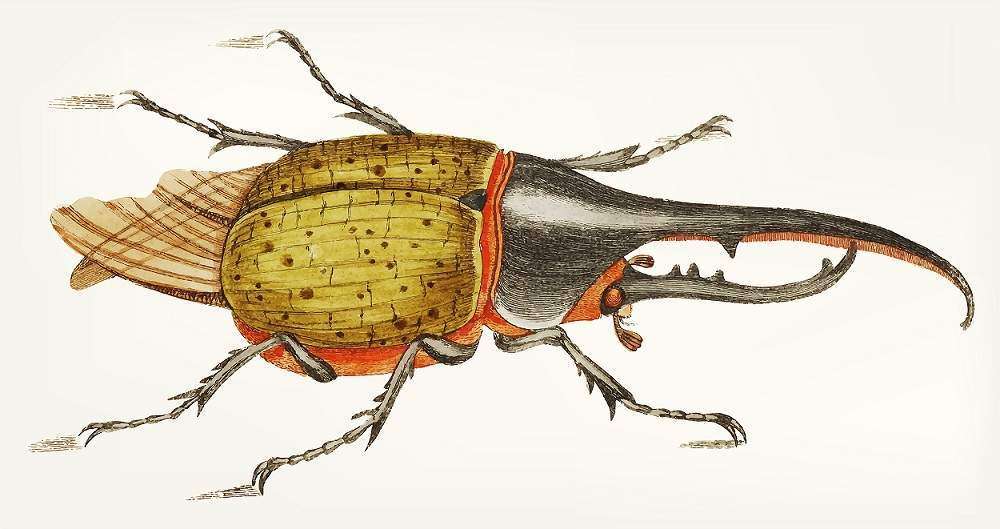
The Hercules Beetle is among the largest flying insects around the world. Hercules is a species of rhinoceros beetle found in the rainforests of Central America, Antilles, Southern Mexico, and South America. Dynestes Hercules is a dynastine scarab beetle in the Scarabaeidae family. The Hercules Beetle is named for the amazing hornlike structures on the front side of males. The males can extend a length of 7 inches. Only the males have trademark horns which they use in breeding season to fight other males. These Hercules have rounded, convex backs, and their colouration varies from black to blotchy greenish-grey. Some are almost metallic, and shiny, whereas others may be covered with fine, short hairs, giving them a velveteen look.
Taxonomy
The genus Dynastes MacLeay consists of 7 species. The other species in the genus are distributed throughout southern North America (Dynastes grantii Horn and Dynastes Titus (Linnaeus) ), South America (Dynastes satanus Moser and Dynastes neptunus Quesnel) (Endrödi 1976, Endrödi 1985, Hardy 2003) and Mesoamerica (Dynastes maya Hardy and Dynastes hyllus Chevrolet). The taxonomy status of Dynastes hercules is uncertain (Ratcliffe et al. 2013), and different treatments can be found throughout the literature (Ratcliffe 2003, Ratcliffe and Cave 2006, Ratcliffe et al. 2013, Dutrillaux and Dutrillaux 2013, Huang 2014).
Several subspecies are found: Dynastes hercules Ecuadorian Ohaus, Dynastes hercules litchi Lachaume, Dynastes hercules hercules Linnaeus, Dynastes hercules morishimai Nagai, Dynastes hercules trinidadensis Chalumeau & Reid, Dynastes hercules occidentalis Lachaume, Dynastes hercules takakuwai Nagai, Dynastes hercules patchouli Grossi & Arnaud, Dynastes hercules septentrionalis Lachaume, and Dynastes hercules reidi Chalumeau.
Distribution
The Hercules beetle are often there in the Lesser Antilles and more from southern Mexico south to Bolivia. Populations of Dynastes Hercules are in areas of lowland rainforest and montane in Colombia, Brazil, Peru, and Ecuador.
Life Cycle
Female beetles put eggs in the soil when they get active during hot months. The eggs conceive and the larvae live underground from six months to one year during which time they get bigger, moult, and pupate underground. A few weeks after pupation, the adult beetles come out. But they remain underground until spring. After the adults come out, the females release a pheromone that fascinates males for mating. With their horns, males fight to find which will mate with the female. After mating, the females then warren into the ground and lay eggs.
Physical Description
Adult body sizes (excluding the thoracic horn) vary between 29 and 42 mm in width and 50 and 85 mm in length. Male Hercules beetles may extend up to 173 mm in length (including the horn), making them the longest species of beetle in the world after including jaws and horns. The size of the horn is naturally variable, more so than any variation of the size of wings, legs, or overall body size in the species. This variability results from developmental mechanisms that coincide with genetic predisposition in relation to stress, nutrition, exposure to parasites, and/or physiological conditions.
Dynastes hercules are highly sexually dimorphic, with only males exhibiting the characteristic horns (a much larger one on the prothorax and one on the head). The colour of the male’s body is black with the deviation of the elytra, which can have shades of olive-green. They have a black suture with scanty distributed black spots elsewhere on the elytra. They have a little iridescent coloration to their elytra, which varies in colour between specimens. It may affecte by the humidity of the local environment in which they grow.
At low humidity, the elytra are yellow or olive-green in colour but darken to black at higher humidity due to their hygrochromic properties. Females of Dynastes hercules have pierce elytra which are mostly fully black but sometimes have the last quarter of the elytra colored in the same way as the males.
Diet And Behavior
Saproxylophagous is the larvae of the Hercules beetle, meaning that they feed on crumbling wood; they reside in the same during their 2-year growth stage. The adult Hercules beetle feeds on crumbling and fresh fruit, along with tree sap. Adult Hercules bettle cut bark through the use of its synchronous mandibles to easily get the sap of trees. When these mandibles closes, a small opening establishes. This can act like a straw to allow consumption of tree sap. They offer feed on apples, peaches, bananas, pears, grapes, and mangoes in captivity.
Physical Strength
Research says that Hercules beetles can carry up to 850 times its body weight. That makes them the strongest animals in the world according to their size.
Behavior
The adult Hercules beetle searches for food at night and hides them in burrows within the leaf during the daytime. They make a huffing sound, made by stridulating their abdomen against their elytra to warn the predators. Like most insects, communications within species is a mix of sight, chemoreception, and mechanical perception. Research on the Dynastes Hercules says that a male placed in the females’ vicinity, will immediately orient towards her and seek her out, suggesting chemical communication through strong sexual pheromones.
Behavior between males
It is common that males will engage in combat to win possession and mating with the female. They typically use their large horns to fight and win mating disputes, this can cause significant physical harm to the combatants but may also include physical harm to the females during the process. During fights, the males attempt to get and pin their rivals between the thoracic and cephalic horns to lift and throw them. The male who successfully did it wins mating rights with the female, though the beetles remain polugynandrous.
The Dynastes Hercules larvae have a great ecological role due to their saproxylophagous lifestyle. They help with biodegradation as well as nutrient cycling. Lately, the rearing of large specimens of Dynastes hercules has become more precious, and breeders try to rear individuals with large horns and body sizes by providing them with optimal nutrition and conditions.